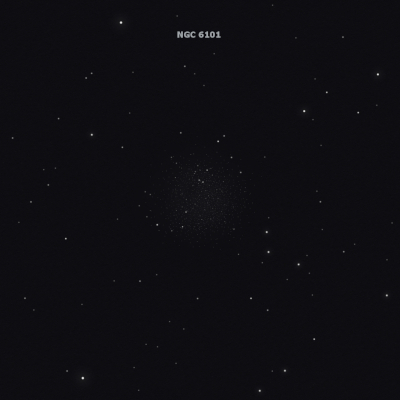
James Dunlop discovered NGC 6101 = D 68 = h3623 on 1 Jun 1826 and recorded "A pretty large rather faint round nebula, about 3.5-4' diameter, a little brighter in the middle. There is a very small nebula on the N.p. side joining the margin of the large nebula." Dunlop's position is off by a relatively small 4'.
On 18 Jun 1835, John Herchel recorded "Globular cluster, large, faint, round, very gradually a little brighter in the middle, all resolved into stars 15..18th mag, 4' diam, with stragglers. A delicate and beautiful object." A week later he called it "pretty bright, large, irregularly round, gradually brighter in the middle, resolved into stars 13..16th mag; pretty compressed, diam 5' or 6' by estimation, approx. 50 seconds in RA. A fine object."
300/350mm - 12" (6/29/02 - Bargo, Australia): at 140x this moderately faint globular is ~4' diameter with just a weak concentration. A scattering of mag 14 stars pepper the face of the cluster and at the edges of the irregular halo.
400/500mm - 18" (7/6/05 - Magellan Observatory, Australia): at 171x; fairly large but apparently loose globular with about two dozen stars resolved and little central concentration. At 228x at least three dozen stars mag 14 and fainter were resolved including a clump of faint stars near the center. At this power the periphery is quite irregular and ragged with most of the brighter resolved stars hugging close to the edges of the halo. A group of brighter mag 11 field stars are just off the NNE side. A mag 10 star lies 8' NW of center and a similar star is placed 7' SE. Located 28' SE of a mag 6.7 star.
18" (7/5/05 - Magellan Observatory, Australia): at 128x appears moderately bright, fairly large, round, 4'-5' diameter. This globular has an unusual appearance, as there was only a weak concentration except for a very small brighter nucleus. At 228x many mag 14-15 stars are superimposed over the background glow while a number of faint stars huddle around the edges of the halo. Several of the faint, resolved stars reside very near the center and these may have been the "very small brighter nucleus" I noticed at only 128x.
Notes by Steve Gottlieb